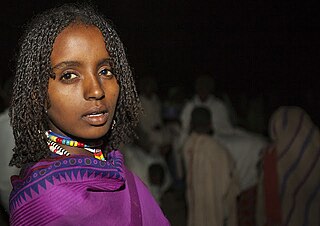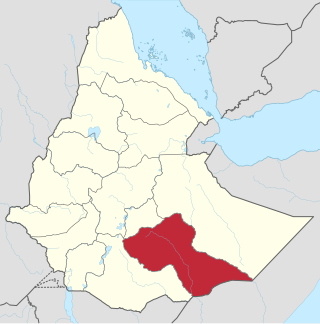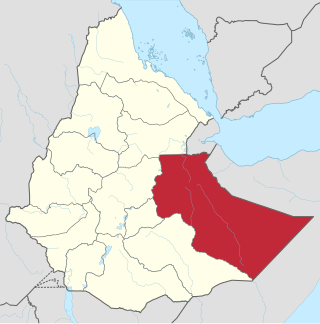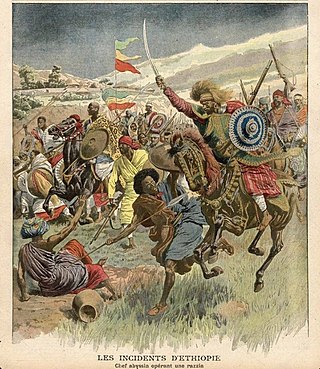
The Oromo people are a Cushitic ethnic group native to the Oromia region of Ethiopia and parts of Northern Kenya. They speak the Oromo language, which is part of the Cushitic branch of the Afroasiatic language family. They are one of the largest ethnic groups in Ethiopia. According to the last Ethiopian census of 2007, the Oromo numbered 25,488,344 people or 34.5% of the Ethiopian population. Recent estimates have the Oromo comprising 45,000,000 people, or 35.8% of the total Ethiopian population estimated at 116,000,000.

Oromia is a regional state in Ethiopia and the homeland of the Oromo people. Under Article 49 of Ethiopian Constitution, the capital of Oromia is Addis Ababa, also called Finfinne. The provision of the article maintains special interest of Oromia by utilizing social services and natural resources of Addis Ababa.

Harar, known historically by the indigenous as Harar-Gey or simply Gey, is a walled city in eastern Ethiopia. It is also known in Arabic as the City of Saints.

Bale, also known as Bali, is the name of two former polities located in the southeastern part of modern Ethiopia.

Hararghe was a province of eastern Ethiopia with its capital in Harar.

Sheikh Hussein is a town in south-eastern Ethiopia. Located in the Bale Zone of the Oromia Region, it has a longitude and latitude of 7°45′N40°42′E with an elevation of 1386 meters above sea level. The Central Statistical Agency has not published an estimate for this town's 2005 population.
Hadiya also known as Adea or Hadia was a medieval Muslim state in the southern part of its realm located south of Shewa and west of Sharkha. The Hadiya Muslim state mainly composed of Cushitic Hadiyya proper, Halaba, Kebena people as well as Semitic Sil'te and other tongues related to Harari language. Hadiya was historically a vassal state of the Adal federation and then became an autonomous province of Abyssinia in the fourteenth century while still remaining a member of the Zeila union. In the 1600s Hadiya regained its independence and was led by a Garad. By 1850, Hadiya is placed north-west of lakes Zway and Langano but still between these areas.

Arsi Province was a province of Ethiopian Empire with its capital at Asella. Historically a part of the Emirate of Harar until its invasion by Menelik and subsequent incorporation into modern Ethiopia. The province was reduced to a Zone of the Oromia Region with the adoption of the new constitution in 1995. In more ancient times, the region is seemingly related to the Harla.

The Marehan is a Somali clan, which is part of one of the largest Somali clan families, the Darod.
Barento is one of the two major subgroups of the Oromo people, a Cushitic ethnic group. They live in the West Hararghe Zone, East Hararghe Zone, Arsi zone, of the Oromia Region of Ethiopia while the other subgroup named Borana Oromo inhabiting Oromia Special Zone Surrounding Addis Ababa, West Shewa Zone, West Welega Zone and Borena Zone of the Oromia Region of Ethiopia.
Hadiya, also spelled as Hadiyya, is an ethnic group native to Ethiopia in Southern Nations, Nationalities and Peoples' Region who speak the Hadiyyisa language. According to a popular etymology, the name 'Hadiyya," sometimes written in the versions Hadya, Hadea, Hadija, Hadiyo, Hadiyeh, Adea, Adia, means "gift of god" A historical definition of the Hadiya people based on the old Hadiyya Sultanate included a number of Ethiopian ethnic groups currently known by other names. Currently, this historic entity is subdivided into a number of ethnonyms, partly with different languages and cultural affiliations. In his book "A History of the Hadiyya in Southern Ethiopia," Ulrich Braukämper reported that Leemo, Weexo-giira, Sooro, Shaashoogo, Baadawwaachcho, and Libido (Maraqo) Hadiyya, Endegang subgroups remain a language entity and preserved identity of oneness, the Hadiyya proper. The term Hadiya specifically designates the Qabeena people. Other ethnic groups such as Siltʼe, Wulbareg, Azarnat, Barbare, Wuriro, Wolane and Gadabano profess that they're the seven Hadiya clans. Ancient Hadiyans are distinguished by their Muslim heritage however these populations have decreased in the following centuries. Clans of Hadiya origin in Oromia, Sidama, Wolayta, Gurage, Tigray, and Afar were completely absorbed by these nations. They were initially all inhabitants of a single political entity, a sultanate, which in the four centuries following its break-up in the mid-16th century fragmented into separate ethnic groups.
The Siltʼe people are an ethnic group in southern Ethiopia. They inhabit the Siltʼe Zone which is part of the Southern Nations, Nationalities and Peoples Region. Silt'e people speak Siltʼe language a Semitic language which is closely related to the Harari language.
The Argobba are an ethnic group inhabiting Ethiopia. A Muslim community, they are spread out through isolated village networks and towns in the north-eastern and eastern parts of the country. Group members have typically been astute traders and merchants, and have adjusted to the economic trends in their area. These factors have led to a decline in usage of the Argobba language. Argobba are considered endangered today due to exogamy and destitution as well as ethnic cleansing by the Abyssinian state over the centuries.

The Harari people are a Semitic-speaking ethnic group which inhabits the Horn of Africa. Members of this ethnic group traditionally reside in the walled city of Harar, simply called Gēy "the City" in Harari, situated in the Harari Region of eastern Ethiopia. They speak the Harari language, a member of the South Ethiopic grouping within the Semitic subfamily of the Afroasiatic languages.
Garad is a term used to refer to a king, Sultan or regional administrator. It was used primarily by Muslims in the Horn of Africa that were associated with Islamic states, most notably the Adal Sultanate.
The Harla, also known as Harala, Haralla are an ethnic group that once inhabited Ethiopia, Somalia, and Djibouti. They spoke the now-extinct Harla language, which belonged to either the Cushitic or Semitic branches of the Afroasiatic family.
Chercher was a province in Hararghe now part of Oromia Region, Ethiopia. Also known as Ittuu and West Hararghe, Chercher is the name given mainly to the eastern escarpment highland areas of Oromia state's West Hararaghe Zone, where the chains of Checher or higher mountains rise and extend inland from the Great Rift Valley in its northwest. The capital of the former Chercher province was Chiro.
The Wolane people are an ethnic group in southern Ethiopia. Wolane people speak a Semitic language which is closely related to Sil'te, Zay and Harari languages.

Menelik's conquests, also known as the Agar Maqnat, were a series of expansionist wars and conquests carried out by Emperor Menelik II of Shewa to expand the Ethiopian Empire.

Early history of Harar city is generally obscure, as many documents and records differ the exact date of the origin of the city. Most historical records state that Harar's history date back to 16th century, beginning with Adal Sultanate moving its capital from Dakkar to Harar during the reign of Sultan Abu Bakr ibn Muhammad. Other rudimentary oral tradition produced in 19th and 20th century stated that Harar history dated by in the 10th century or Abadir Umar ar-Rida founded the first Harar kingdom after migrating from Arabian Peninsula to spread Islam in 12th and 13th century.












